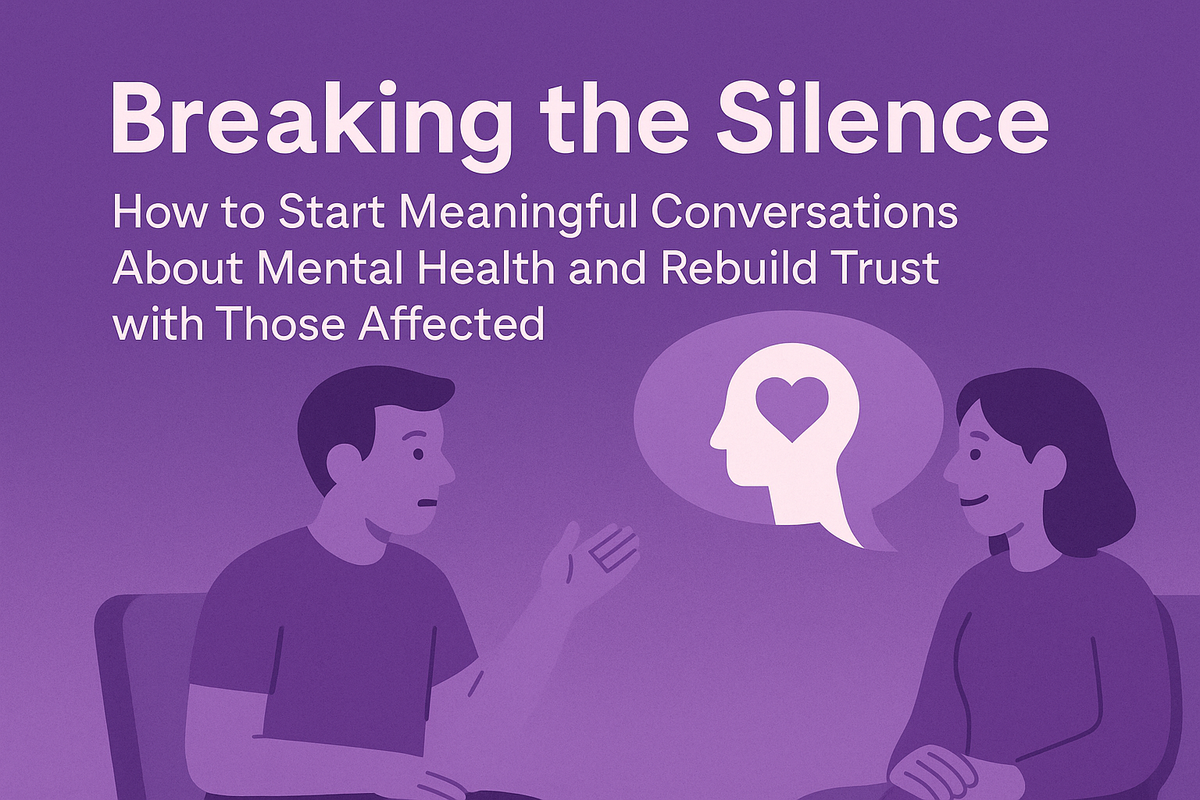Breaking the Silence: How to Start Meaningful Conversations About Mental Health and Rebuild Trust with Those Affected

In a world where mental health struggles often lurk in the shadows, breaking the silence is essential for healing and connection. Conversations about mental health have the power to transform lives, foster understanding, and ultimately rebuild trust between those affected and their loved ones. But where do we start? Navigating these discussions can feel daunting, yet initiating them is the first step towards creating a support network that encourages openness and compassion. By embracing vulnerability and providing a safe space for dialogue, we can dismantle the stigma surrounding mental health issues. Join us as we explore practical strategies and insights to help you initiate meaningful conversations, empowering both yourself and those you care about. Together, we can shine a light on mental health, fostering a culture of empathy and understanding that encourages healing for everyone involved.
Understanding the Importance of Mental Health Conversations
In today’s fast-paced world, mental health issues affect millions of people globally, yet the topic remains shrouded in silence and stigma. The importance of mental health conversations cannot be understated as they play a crucial role in promoting awareness, understanding, and support. By openly discussing mental health, we create a culture where individuals feel safe to share their experiences without fear of judgment or discrimination. This openness can lead to early intervention, better coping strategies, and ultimately, improved mental well-being.
Mental health conversations are essential for breaking down the barriers that prevent people from seeking help. When individuals feel comfortable talking about their mental health, they are more likely to reach out for support, whether it be from friends, family, or professionals. This willingness to seek help can significantly impact their recovery journey and overall quality of life. Moreover, these discussions can educate others about the signs and symptoms of mental health issues, enabling them to provide timely support and assistance to those in need.
Furthermore, conversations about mental health can help to normalize the topic and reduce the stigma associated with it. When we openly discuss mental health, we challenge the misconceptions and stereotypes that perpetuate discrimination and isolation. This normalization can foster a more inclusive environment where everyone feels valued and understood, regardless of their mental health status. By prioritizing mental health conversations, we can create a society that is more compassionate, empathetic, and supportive of those who are struggling.
Common Myths and Misconceptions About Mental Health
Despite growing awareness, many myths and misconceptions about mental health persist, contributing to the stigma and barriers to seeking help. One common misconception is that mental health issues are a sign of weakness or a character flaw. In reality, mental health conditions are medical issues, much like physical illnesses, and they can affect anyone regardless of their strength or character. This myth can prevent individuals from seeking help and lead to feelings of shame and isolation.
Another prevalent myth is that mental health problems are rare and only affect a small portion of the population. However, statistics show that mental health issues are quite common, with one in four people experiencing a mental health condition at some point in their lives. This misconception can lead to a lack of understanding and empathy for those who are struggling, as well as inadequate resources and support systems. Recognizing the widespread nature of mental health issues is crucial for fostering a more supportive and informed community.
A third misconception is that people with mental health conditions are dangerous or unpredictable. This stereotype is harmful and inaccurate, as the majority of individuals with mental health issues are not violent and are more likely to be victims of violence than perpetrators. This myth can lead to discrimination and exclusion, further exacerbating the challenges faced by those with mental health conditions. By debunking these myths and promoting accurate information, we can create a more supportive and understanding environment for everyone.
Creating a Safe Space for Open Dialogue
Creating a safe space for open dialogue about mental health is essential for fostering trust and encouraging meaningful conversations. A safe space is an environment where individuals feel comfortable expressing their thoughts and feelings without fear of judgment or repercussions. To create such a space, it’s important to approach conversations with empathy, patience, and an open mind. This means actively listening to others, validating their experiences, and refraining from making assumptions or offering unsolicited advice.
One way to create a safe space is by setting clear boundaries and expectations for the conversation. This can include agreeing on confidentiality, respecting each other’s perspectives, and allowing for breaks if the discussion becomes overwhelming. Establishing these guidelines can help participants feel more secure and supported, making it easier for them to share their experiences and emotions. Additionally, being mindful of language and avoiding stigmatizing or dismissive terms can contribute to a more respectful and inclusive atmosphere.
Another important aspect of creating a safe space is fostering a sense of trust and mutual respect. This can be achieved by demonstrating genuine care and concern for the well-being of others, as well as being consistent and reliable in your support. Building trust takes time and effort, but it is a crucial component of any meaningful conversation about mental health. By creating a safe space, you can encourage open and honest dialogue, helping to break down the barriers that prevent people from seeking help and support.
Effective Communication Techniques for Discussing Mental Health
Effective communication is key to having meaningful conversations about mental health. One important technique is using “I” statements, which can help to express your feelings and concerns without sounding accusatory or judgmental. For example, saying “I feel worried when you seem distant” is more constructive than “You are always so withdrawn.” This approach can help to create a more open and non-confrontational dialogue, making it easier for the other person to share their thoughts and feelings.
Another effective communication technique is practicing active listening, which involves fully concentrating on what the other person is saying and responding thoughtfully. This means not interrupting, making eye contact, and providing verbal and non-verbal feedback, such as nodding or saying “I understand.” Active listening can help to validate the other person’s experiences and show that you genuinely care about their well-being. It also encourages them to continue sharing, fostering a deeper and more meaningful conversation.
It’s also important to be mindful of your body language and tone of voice during these conversations. Non-verbal cues, such as maintaining an open posture, making eye contact, and using a calm and reassuring tone, can convey empathy and support. On the other hand, crossed arms, averted gaze, or a harsh tone can make the other person feel defensive or misunderstood. Being aware of these non-verbal signals can help to create a more positive and supportive environment for discussing mental health.
How to Approach Someone Who May Be Struggling
Approaching someone who may be struggling with their mental health can be challenging, but it is an important step in offering support and encouraging them to seek help. The first step is to choose an appropriate time and place for the conversation. Find a private and comfortable setting where you can talk without interruptions, and make sure you have enough time to listen and respond thoughtfully.
When initiating the conversation, it’s important to express your concern in a non-judgmental and compassionate manner. You can start by mentioning specific behaviors or changes you’ve noticed, such as “I’ve noticed that you’ve been more withdrawn lately, and I’m concerned about you.” Avoid making assumptions or diagnosing their condition, and instead focus on expressing your care and willingness to listen. This approach can help to create a safe and supportive environment for the person to share their feelings.
Once the conversation is underway, it’s important to respect the other person’s boundaries and be patient. They may not be ready to open up right away, and that’s okay. Let them know that you are there for them whenever they are ready to talk, and continue to offer your support in a non-intrusive way. Encourage them to seek professional help if needed, and offer to assist them in finding resources or making appointments. By approaching the conversation with empathy and patience, you can help to create a supportive network for the person to lean on.
The Role of Active Listening in Mental Health Conversations
Active listening is a critical component of effective communication, especially when discussing mental health. It involves fully engaging with the speaker, showing empathy, and responding thoughtfully. By practicing active listening, you can create a supportive and validating environment for the person to share their thoughts and feelings. This can help to build trust and encourage more open and honest conversations about mental health.
To practice active listening, it’s important to give the speaker your full attention. This means putting away distractions, making eye contact, and using body language to show that you are engaged. It’s also important to listen without interrupting or thinking about your response while the other person is speaking. Instead, focus on understanding their perspective and validating their feelings. You can do this by nodding, using verbal affirmations like “I understand” or “That sounds difficult,” and summarizing what they have said to show that you are listening.
Another key aspect of active listening is responding with empathy and support. This means acknowledging the other person’s feelings and experiences without judgment or criticism. You can do this by saying things like “It sounds like you’re going through a lot right now, and I’m here for you.” Avoid offering unsolicited advice or trying to fix their problems, as this can come across as dismissive or patronizing. Instead, focus on being a supportive and understanding presence, and let the other person know that you are there to listen and help in any way you can.
Building Trust: Overcoming Stigma and Fear
Building trust is essential for having meaningful conversations about mental health, but it can be challenging due to the stigma and fear surrounding the topic. One way to overcome these barriers is by educating yourself and others about mental health issues. This can help to dispel myths and misconceptions, reduce stigma, and create a more informed and supportive environment. By showing that you are knowledgeable and understanding, you can build trust and encourage others to open up about their experiences.
Another important aspect of building trust is being reliable and consistent in your support. This means following through on your commitments, being available when you say you will be, and showing genuine care and concern for the other person’s well-being. Consistency can help to build a sense of security and trust, making it easier for the person to share their thoughts and feelings. It’s also important to respect the other person’s boundaries and be patient, as building trust takes time and effort.
Finally, it’s important to address and challenge any stigma or discrimination that may arise during conversations about mental health. This can include calling out harmful language or behaviors, promoting accurate information, and advocating for mental health awareness and support. By actively working to reduce stigma and create a more inclusive and supportive environment, you can help to build trust and encourage more open and honest conversations about mental health.
Resources and Tools for Supporting Mental Health Discussions
There are many resources and tools available to support mental health discussions and promote awareness and understanding. One valuable resource is mental health organizations, such as the National Alliance on Mental Illness (NAMI), Mental Health America (MHA), and the World Health Organization (WHO). These organizations provide a wealth of information on mental health issues, including signs and symptoms, treatment options, and support resources. They also offer educational materials, support groups, and advocacy opportunities to help individuals and communities better understand and support mental health.
Another valuable resource is mental health professionals, such as therapists, counselors, and psychiatrists. These professionals can provide expert guidance and support for individuals struggling with mental health issues, as well as offer advice on how to have meaningful conversations about mental health. Many mental health professionals also offer workshops, training sessions, and support groups to help individuals and communities develop the skills and knowledge needed to support mental health discussions.
In addition to these resources, there are many online tools and apps available to support mental health and promote awareness. These tools can include mental health screening tools, self-help resources, and online support communities. Many of these tools are free and easily accessible, making them a valuable resource for individuals and communities looking to support mental health discussions. By utilizing these resources and tools, you can help to create a more informed, supportive, and compassionate environment for discussing mental health.
Encouraging Ongoing Conversations: Strategies for Sustained Engagement
Encouraging ongoing conversations about mental health is essential for creating a supportive and understanding environment. One strategy for sustained engagement is to regularly check in with the people in your life and ask how they are doing. This can help to normalize conversations about mental health and show that you care about their well-being. It’s important to approach these check-ins with empathy and patience, and to be prepared to listen and offer support if needed.
Another strategy is to create opportunities for group discussions and activities focused on mental health. This can include organizing mental health awareness events, hosting support groups, or facilitating workshops and training sessions. These activities can help to promote awareness and understanding of mental health issues, as well as provide a safe and supportive environment for individuals to share their experiences and seek support. By creating these opportunities, you can help to foster a culture of openness and support around mental health.
It’s also important to advocate for mental health awareness and support in your community. This can include promoting mental health resources and services, advocating for mental health education and training, and supporting policies and initiatives that promote mental health awareness and support. By taking an active role in promoting mental health, you can help to create a more informed and supportive community that encourages ongoing conversations about mental health.
Conclusion: The Path to a More Supportive Community
In conclusion, breaking the silence and starting meaningful conversations about mental health is essential for promoting awareness, understanding, and support. By recognizing the importance of mental health conversations, dispelling common myths and misconceptions, and creating a safe space for open dialogue, we can help to reduce stigma and encourage more open and honest discussions about mental health. Utilizing effective communication techniques, practicing active listening, and building trust are crucial components of these conversations.
Additionally, utilizing resources and tools, encouraging ongoing conversations, and advocating for mental health awareness and support can help to create a more informed and supportive community. By taking these steps, we can foster a culture of empathy, understanding, and compassion that encourages healing and connection for everyone involved. Together, we can shine a light on mental health and create a more supportive and inclusive environment for all.
Through our collective efforts, we can break down the barriers that prevent people from seeking help and create a community where everyone feels valued and understood. By embracing vulnerability, providing support, and promoting awareness, we can help to rebuild trust and foster a culture of empathy and understanding. Let’s continue to have these important conversations and work together to create a more supportive and compassionate community for all.
By: Jess E




